Curiosities
Why Did Lindsay Lohan’s Art Spark Furries’ Fury? What Is the ‘Shadowman Experience’? + More Questions I Have About the Week’s Art News
Plus, what is Ted Lasso's take on the rise of African art?

Plus, what is Ted Lasso's take on the rise of African art?

Curiosities is a column where I comment on the art news of the week, sometimes about stories that were too small or strange to make the cut, sometimes just giving my thoughts on the highs and lows.
Below, some questions posed by the events of the last week…
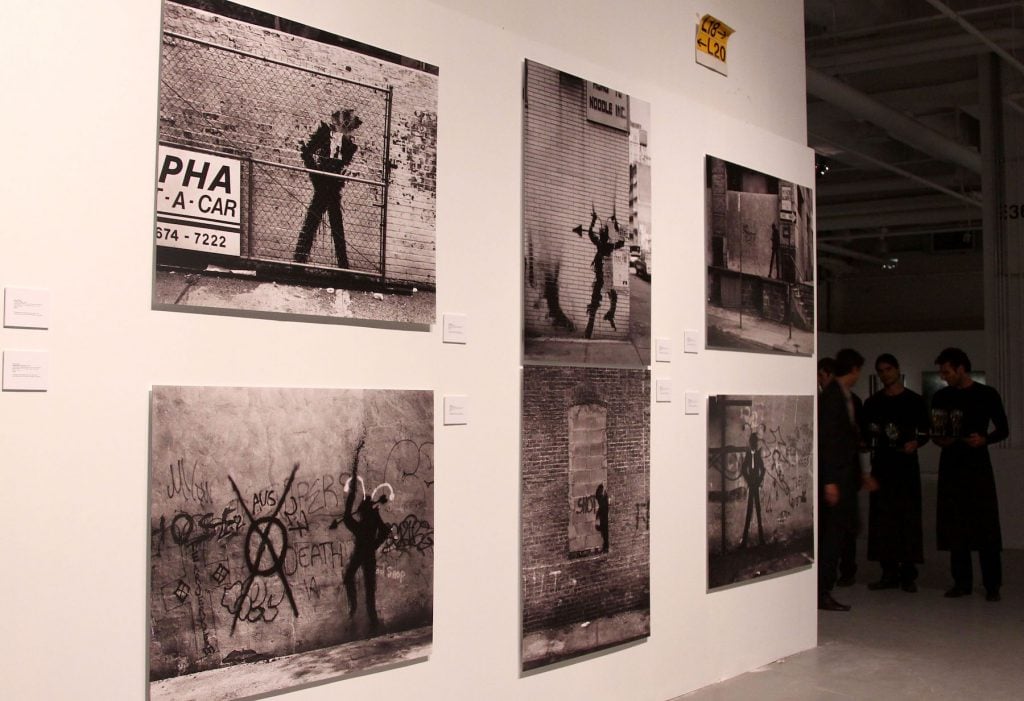
Photos of Richard Hambleton “Shadowman” works in situ, seen in “Richard Hambleton – New York” on September 15, 2009 in New York, New York. (Photo by Astrid Stawiarz/Getty Images)
Recently, splattery silhouettes resembling figures lurking in alleyways have been popping up all across NYC. They look like the signature “Shadowman” works of Richard Hambleton, the pioneer of ’80s street art who died in 2017. People have been wondering—what are they? Rip-offs, the latest in ‘80s nostalgia, something else?
Thanks to a Times piece last week, now we know. While the originals were sly street interventions playing on the anxiety and grit of ‘80s New York, the new ones very much reflect the cultural zeitgeist of 2021. Which is to say that they are reboots meant to promote an immersive experience. And also there is a financial fraud angle.
Basically, art dealer and self-described art-world “disrupter” (shudder) Andrew Valmorbida purchased the rights to all of Hambleton’s work in the final year of the troubled artist’s life, when he needed money, for $1 million. Now, Valmorbida has authorized another Hambleton fan, a “former mountain bike racer and industrial designer” who goes by Nullbureau, to hit the streets of Gotham making new Shadowmen (with easy-to-wash-off paint).
Some of the new works, at places like a Supreme store and Hauser & Wirth (plus plans to hit Miami in the lead up to Art Basel!), have QR codes that take you to the Hambleton site owned by Valmorbida’s Untitled-1 Holdings (until recently, it was advertising an impending Hambleton NFT, but this has vanished).
The Times revealed that Valmorbida was actively looking for brand sponsors for an immersive “Shadowman Experience” in London, modeled on the unauthorized Banksy touring experience, complete with a skate park and concessions. It is to be designed by Hotdog Productions, which mainly does luxury product launches and VIP events, plus the odd sweet 16 party. The mockup shows “family-friendly” galleries filled with oversized mock Shadowman silhouettes, seemingly capturing neither the “street” nor the “art” part of Hambleton’s street-art legacy.
In the NYT story, Brian Vincent Kelly, executor of the Hambleton estate, says approvingly of the Hambleton homages in New York, “it’s getting people to talk about Richard Hambleton again, who wanted to be remembered.” True, true, and he deserves to be—but the idea of the “Shadowman Experience” is like him getting his wish courtesy of the dumb wishing rock from Wonder Woman 1984 that grants it in the worst possible way (speaking of poorly thought out ’80s nostalgia).
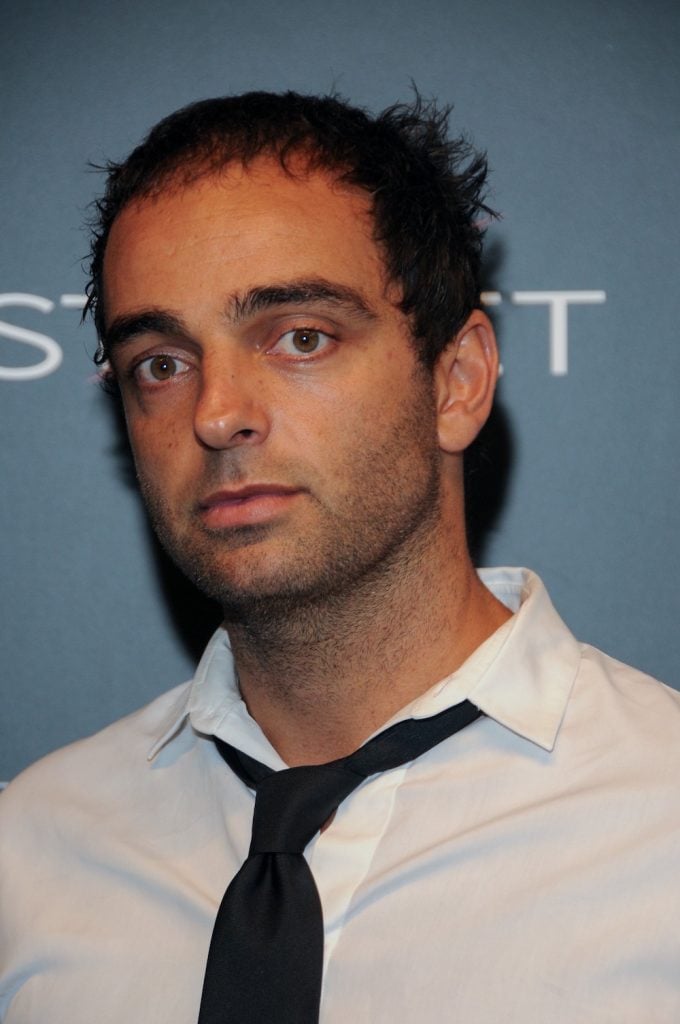
Andrew Valmorbida at the “Future-Shock” exhibition in New York in 2012. Photo: Alli Harvey/Getty Images.
And no sooner was the ink dry on the Times story than there was another twist, as my colleague Eileen Kinsella reported: Andrew Valmorbida reached a settlement for financial misdeeds in Jersey, in the British Islands, mainly having to do with taking out loans while using art that he didn’t own as collateral. The court dubbed Valmorbida so flagrant that it took the unusual step of publicly releasing a statement about his activities, deeming it “of substantial general interest” for anyone who might do business with him to know that he was “a man who was serially dishonest.”
I know it’s a little too neat to align the idea of Valmorbida’s misuse of Hambleton’s art for a “Shadowman Experience” with his misuse of art in other, more seriously fraudulent ways. But it is a neat coincidence, isn’t it?
So, I know that Ted Lasso is many, many people’s preferred form of televisual Ambien, but I haven’t really gotten too into it because, well, who has time to figure out Apple TV (is this something you sign up for?). But this clip did come across my feed:
The goofy joke about meeting Banksy, which caused a ton of interest in the recap-osphere, isn’t even the most significant part of it. The most notable part is the fact that the titanic interest in contemporary African art and the question of who will own it is officially a mainstream story, on the Ted Lasso level.
The show’s enigmatic Nigerian billionaire Edwin Akufo’s charm offensive to poach a star footballer via secretly renting out a British Museum strikes me as more creepy flex than fairytale. Maybe this is just because I feel like the best-known real-life reference point for Akufo is probably the late Congolese-Angolan super-collector Sindika Dokolo, who went from sponsoring parties for African artists at Documenta and winning scads of glowing press for championing African art to being brought low by epic corruption charges, with Angola trying to recover about $1 billion (see: the Luanda Leaks).
So, I’m glad to hear that the Edwin Akufo character takes a turn in the end that makes it all a little less syrupy (though I have to say this raises some questions about the ethics of the Lasso-verse version of Banksy). The reveal is not exactly as trenchant as Frantz Fanon writing on the cynical use of cultural nationalism by the post-colonial bourgeoisie—but it is something.
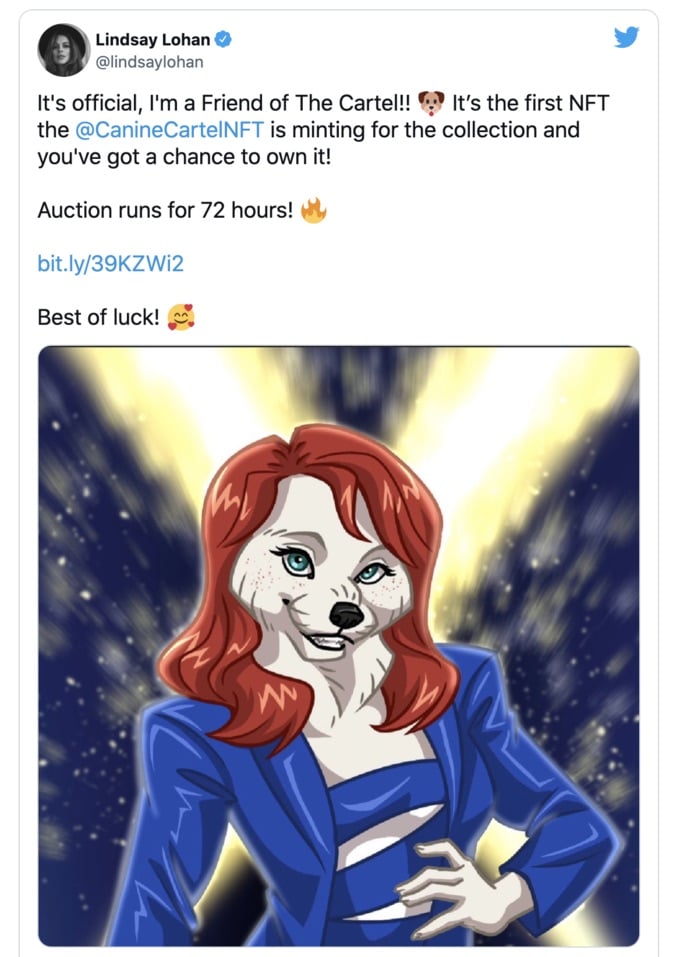
Screenshot of Lindsay Lohan’s now-deleted Tweet announcing her collaboration with Canine Cartel.
With NFT week upon us in New York, let us revisit Lindsay Lohan’s dipping of her paw into the NFT space. The Mean Girls star drew many, many bemused headlines in late September when, in a (now-deleted) tweet, she posted an avatar version of herself as a confident, red-haired dog-woman in a blue power suit and some kind of complicated strappy top.
This was meant as a promo for a truly terrible NFT collection called Canine Cartel, which, in the cutting-edge style that makes NFTs the Art of Now, features 10,000 cartoon avatars of a drug gang, evidentially modeled off of the murderous Sinaloa cartel—only they are all dogs, some of them with sombreros. “You’re one loco cabrón for coming in here,” the site admonishes you, making the Taco Bell Chihuahua look like a cultural sensitivity trainer.
Unfortunately, the intervention of Lohan proved more of a curse than a blessing. For some reason, all of Twitter immediately interpreted the doggy Lindsay Lohan pic through the lens of the furry subculture of people who like to frolic—and sometimes make epic love—in plush animal costumes. Assuming that Lohan was announcing her “fursona” to the world, the target demographic of animal-avatar aficionados turned on the NFT collection, accusing Lohan and her paymasters at the Canine Cartel of cultural appropriation of the furry scene.
“It reminds me in a way of frequently insecure straight artists rendering furries: [diminish] and reduce furry traits so as to not ‘commit’ to what you’re doing,” one furry artist named Colin Spacetwinks told Rolling Stone. “Ears covered, why? Feels like it’s avoiding animal traits on purpose.” The fact that Lohan didn’t commit to enormous dog ears seemed to be a big thing.
Hey, whoever made the character forgot ears and tail. I went ahead, fixed and as you can see also minted it in the process. pic.twitter.com/QJ13YIppiu
— Cryptid IT-Gremlin (@SquishTorimi) September 30, 2021
There were more substantial critiques. “A lot about the design actually seems to be made so they can quickly swap out colors and such which makes sense given the nature of NFTs,” said another artist known as Kaide. “Most of the top tier furry artists and furries at large (but not all) stand against NFTs due to the environmental impact of them.” Some moral clarity from the furry art community!
So exactly a month after the Lohan’s path-breaking “Friends of the Cartel Canine” drop, how are things going with the Canine Cartel? On October 1, “Lindsay Lohan” sold for 1.3 ETH to a buyer who has relisted it for 20 ETH, or about $84,000 at the current rate. There have been no offers for “Lindsay Lohan,” at that or any lower price, as far as I can tell.
As for the broader Cartel, looking at the stats on average sale price and trade volume, it appears that the Dogs are failing to arouse. They have now opened a special “underground casino” game for members as a new perk for Canine owners. Take a look at the promo tweet and get a glimpse the pure, unbridled cool that our NFT future promises us, which also strangely looks like a free-to-play app game:
?CASINO TEASER?
Get your snouts out of your breakfast and take a gander at this teaser for Cigar Lounge Slots—the first Canine Casino game, currently under development!!! ?
Who's ready to test their luck for some free NFTs???
Coming Oct 25th for holders only ?
WOOF WOOF pic.twitter.com/dk2sgwkFgC
— Canine Cartel (@CanineCartelNFT) October 19, 2021
Occupying the polar opposite point on the artistic compass from Canine Cartel is Brazilian artist Clara Ianni’s Labor Drawing (New Museum) (2021) at the New Museum’s just-opened Triennial. In the form of 14 minimalist line drawings on gridded paper, it represents the commute to and from work for different (unnamed) workers at the museum.
I’m not sure what it means that one of the most memorable artworks at the New Museum right now is about what a drag it is to get to the New Museum.
Who has the best commute? That’s tough. Looks like a lot of people work near the museum and bike there. Someone in the “Development Department” works mostly from home, meaning they are just a stationary dot on the page. As for the worst commute, it depends on how you reckon.
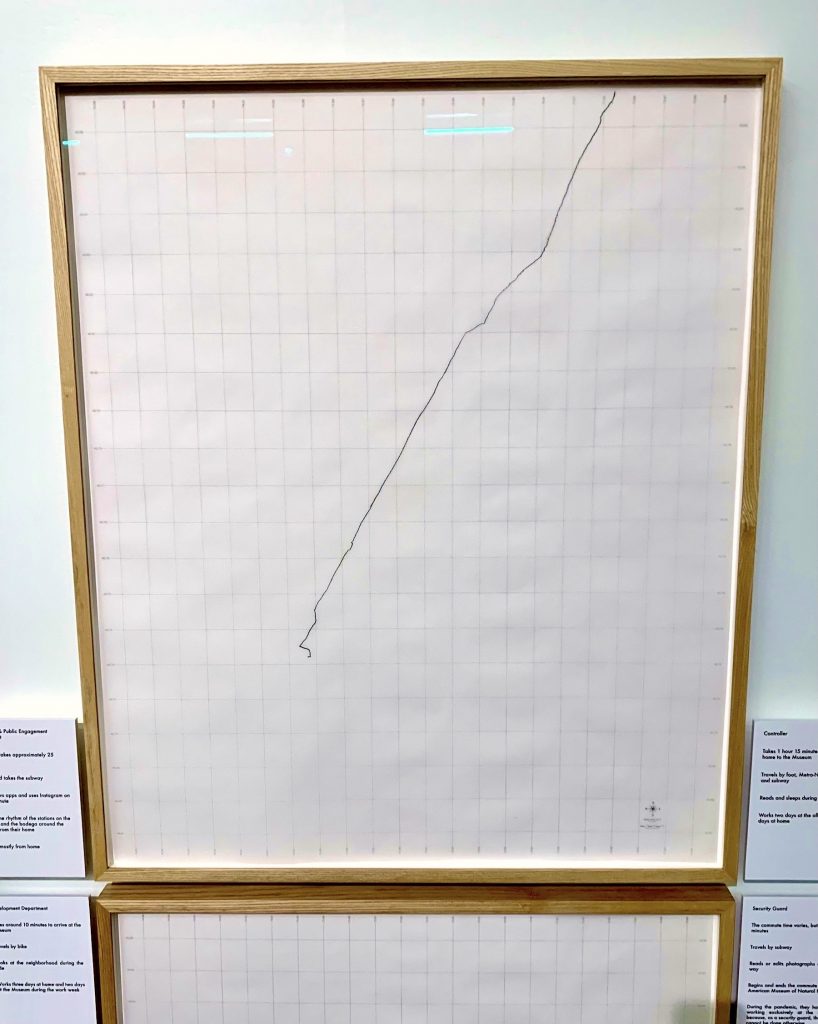
The “Controller” drawing for Clara Ianni’s Labor Drawing (New Museum).
The “Facilities Director” has a 40-minute commute, which involves a train but also a motorcycle. The “Controller” takes a whopping 1 hour and 15 minutes to get in—but only has to actually do that two days a week.
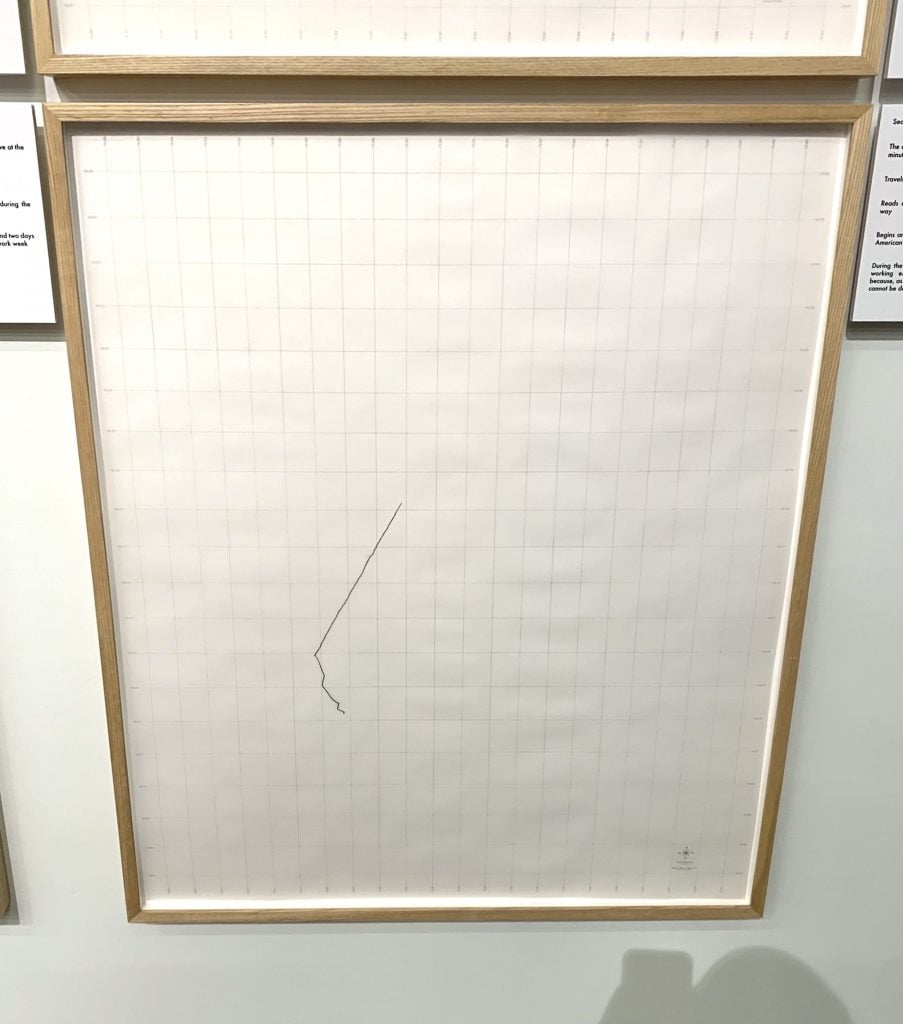
The “Security Guard” drawing for Clara Ianni’s Labor Drawing (New Museum).
But a “Security Guard” has a 45-minute subway commute from the Upper West Side. And they have to actually work in the museum and listen to the Triennial’s video art on loop, five days a week.